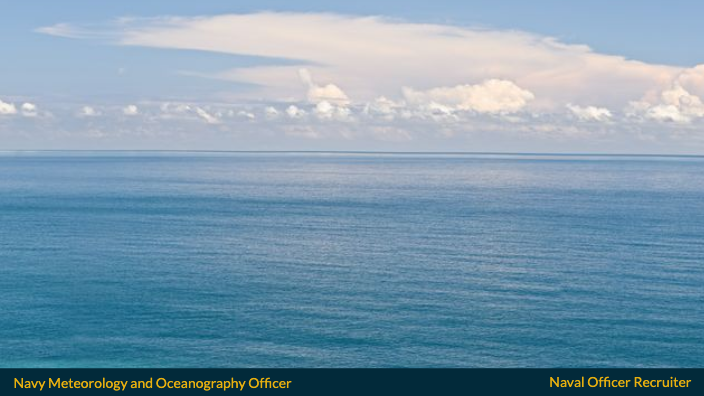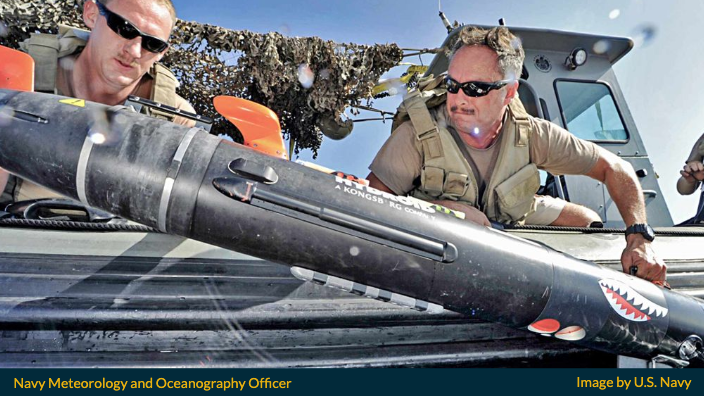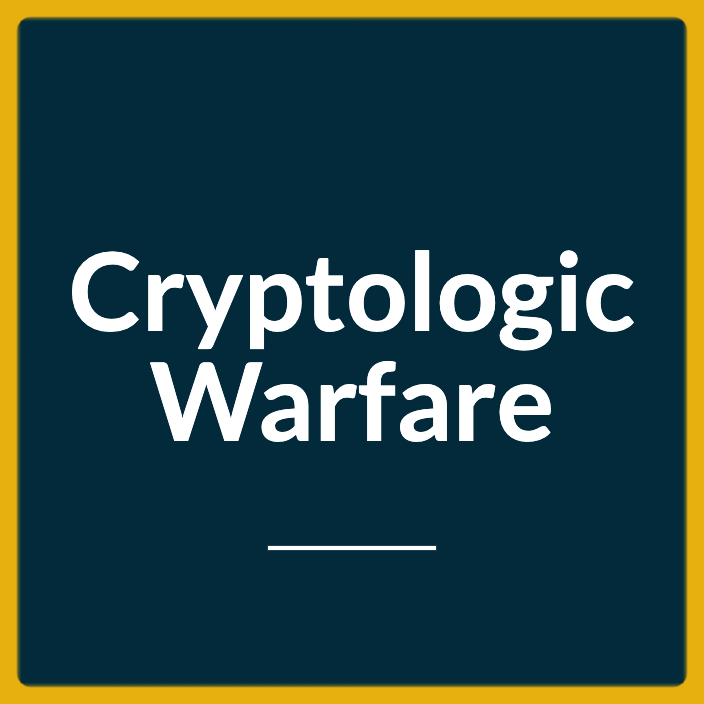Last Updated on March 4, 2024
This guide provides useful information that will help you with your decision to become a Meteorology and Oceanography Officer in the Navy during Fiscal Year 2024.
Oceanographic Officers (OCEANO), also known as Meteorology and Oceanography Officers (METOC), are Restricted Line Officers who serve as the Navy’s geophysical specialists, with a thorough understanding of meteorology, oceanography, hydrography, and accurate time and astrometry.
The Navy Officer designator code for Meteorology and Oceanography Officer is 1800.
Let us go into more detail.
Meteorology and Oceanography Officer Job Description
Navy oceanographers assist operational commanders in enhancing their fighting capabilities by analyzing and predicting environmental variables that might affect military operations.
They provide a timely and precise picture of the battle space, from the depths of the ocean to the furthest reaches of space.
Additionally, they are in charge of mapping the ocean bottom and operating the military’s primary master clock, which gives the world’s most exact time intervals and powers the Global Positioning System (or GPS).

Responsibilities
U.S. Navy equipment, personnel, and decision-making all depend on the technical and tactical guidance of Navy Meteorology and Oceanography (METOC) Officers, whether they are operating in the air, at sea, or undersea.
They use skills in all elements of oceanography, meteorology, hydrography, accurate timekeeping, and astronomy to perform the following tasks:
- Contribute to the navigation of ships, planes, and soldiers by making suggestions based on weather predictions and sea conditions
- Provide military and civilian agencies with forecast updates and weather warnings
- Create charts and maps of the ocean, sea, and waterways for a variety of purposes ranging from simple navigation to search-and-rescue missions
- Maintain the military’s primary master clock, which maintains the world’s most exact time intervals and powers the Global Positioning System (GPS)
- Supervise the Aerographer’s Mates‘ job – Enlisted Sailors who keep an eye on the weather conditions and offer timely weather forecast information
Assignments
Navy meteorologists and oceanographers work in a range of environments and duty stations across the globe, from aircraft carriers and amphibious ships to doing research at the Naval Observatory and Naval Research Labs.
Additionally, staff Oceanographers will have the option to continue your study at Naval Postgraduate School.
Guiding Principles
Warfare Competence
U.S. Navy Oceanographers develop expertise in the geophysical environment, which has an impact on 9 critical areas of warfare:
- Fleet operations
- Aviation
- Navigation
- Anti-submarine warfare
- Mine warfare
- Expeditionary warfare
- Naval special warfare
- Precise time
- Intelligence, surveillance, and reconnaissance
Leadership
All Navy Officers must possess the ability to lead.
Naval Meteorology-Oceanography officers are called upon to lead anything from a tiny deployable oceanography team of 3 to 4 people to commands of more than 400 military and civilian personnel.
How to Become a Navy Meteorology and Oceanography Officer
To become a Navy Meteorology and Oceanography Officer, applicants must be American citizens who are 18 to 42 years old with at least a bachelor’s degree and a GPA of at least 2.8 on a 4.0 scale. OCEANO applicants must also score at least a 45 on the Officer Aptitude Rating (OAR) exam.

Basic Eligibility Requirements
The Navy OCEANO eligibility requirements below are current as of October 2022, per the Navy Personnel Command. No updates have been issued so far.
Citizenship
Applicants must be United States citizens.
Gender
This position is open to both men and women.
Age
Navy OCEANO or METOC applicants must be between the ages of 18 and 42 at the time of commissioning.
Applicants for the Surface Warfare Officer (SWO – OCEANO option) must be under the age of 29 at the time of commissioning.
Education
A bachelor’s degree from a regionally authorized university is required for all Navy OCEANO applicants.
Although not essential, major subjects of study in science, meteorology, oceanography, mathematics, physics, and engineering are greatly encouraged.
Students must have a cumulative grade point average of 2.8 or above on a 4.0 scale to qualify.
Successful completion of a calculus series (minimum of Calculus I and II) with a grade of “C” or higher is necessary, as is successful completion of a calculus-based physics course (Physics I and II) with a grade of “B” or higher.
Academic waivers will be given only to candidates who fulfill the minimum waiverable academic profile code for the Meteorology and Operational Oceanography program at the Naval Postgraduate School.
Physical
In accordance with Chapter 15 of the Manual of the Medical Department, applicants must be eligible for global deployment and physically capable of performing sea duty.
Aptitude
All Navy OCEANO candidates are required to take the OAR test and obtain a minimum OAR score of 45.
The most crucial requirement that you can fully control is your OAR score. It is the primary objective criteria upon which all applicants are compared against.
To maximize your chances of obtaining an exceptional OAR score, we only recommend this OAR Study Guide for your success. All others are mediocre at best.
Professional Experience
Prior military or civilian expertise in physical oceanography, meteorology, hydrography, or geospatial information and systems is highly desirable.
The applicant’s military employment experience must be substantiated by submitting three recent witnessed enlisted performance assessments. This stipulation may be waived.
Leadership Experience
A track record of demonstrated leadership, managerial, or supervisory experience in academic, civilian, or military institutions is greatly recommended.
Security Clearance Eligibility
Candidates must fulfill the requirements of the Director of National Intelligence’s (DNI) Intelligence Community Directive (ICD) 704 for access to classified material.
Prior to final selection as an officer candidate, applicants who are recommended for a commission must conduct a pre-nomination interview with the local special security officer.
Being a dual citizen (i.e., a citizen of the United States and another nation) is not automatically disqualifying.
Risks to national security shall be considered on an individual basis, in accordance with ICD 704.
Waivers
If an applicant does not fulfill all the standards but has an extraordinary record or demonstrated skill set that the Navy needs, a waiver may be granted in restricted quantities.
Navy OCEANO Service Obligation
From the date of appointment, OCEANO selectees shall be required to serve on active duty for 4 years.
The remaining service required to accomplish 8 years of total obligatory service may be spent in the Ready Reserve status.
SWO (OCEANO Option)
Upon redesignation to 1800, SWO (OCEANO option) officers are subject to an extra minimum service requirement in accordance with MILPERSMAN 1212-050, which must be satisfied simultaneously with any other obligations.
More Information
If you want more information about becoming a Navy Meteorology and Oceanography Officer, the next logical step is to contact a Naval Officer Recruiter.
Let us start figuring out how you can benefit from becoming a Navy OCEANO or METOC – or if it is even the right move for you, considering your current life situation.
People were also interested in other Restricted Line jobs, such as Navy Intelligence Officer and Nuclear Reactors Engineer jobs. Check them out.
Hope this was helpful for your career planning.


